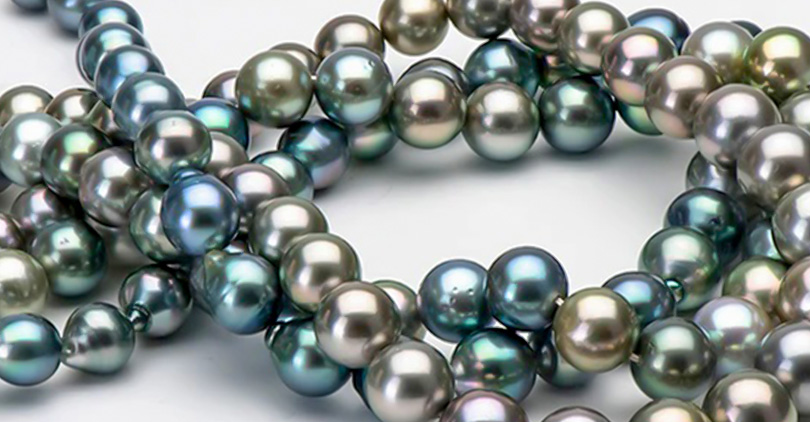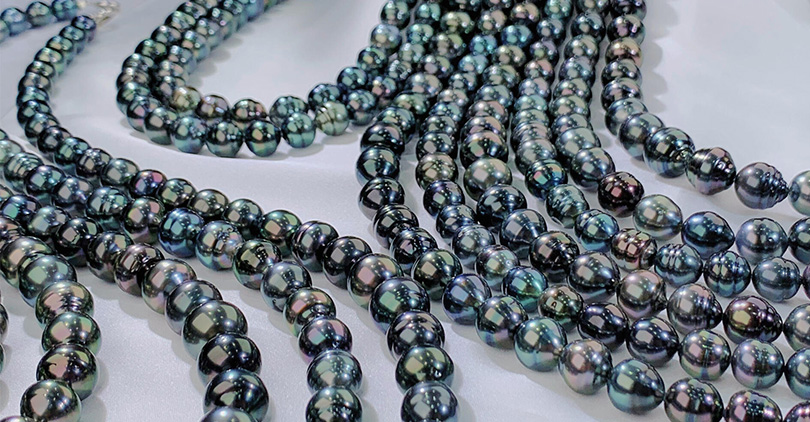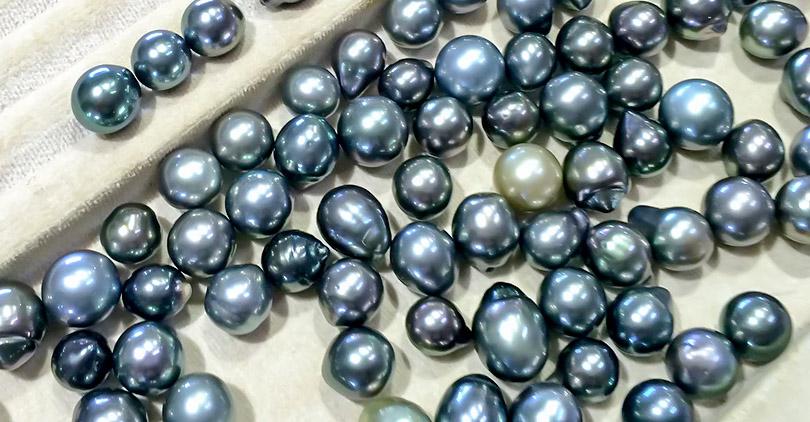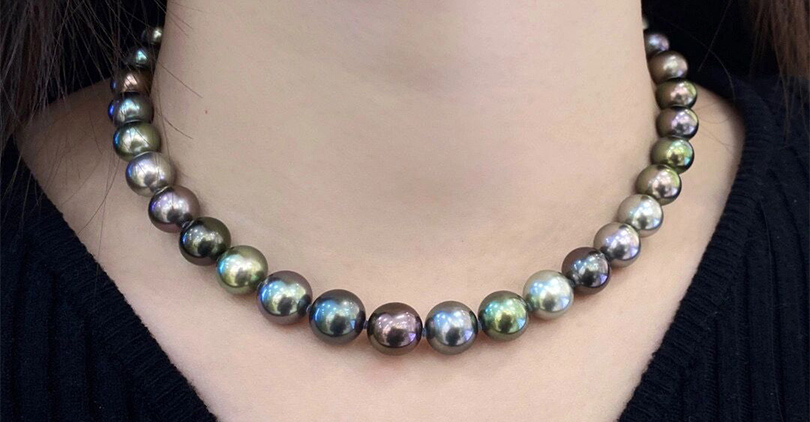The Ultimate Guide to Black Pearls and How Much Are They Worth


Welcome to the ultimate guide to black pearls! Known as the “queen of gems,” there’s nothing quite like them. If you mention Tahitian pearls to any pearl fanatic, just watch their knees go wobbly.
We’ll walk you through their fascinating history, the different types available – and why they’re so incredibly special. Consider us your pearl-loving pilot fish. No matter whether you’re already a fan of these beautiful orbs or simply interested in learning more about them.
We’ll answer all your queries, from where black pearls come from (prepare to be amazed, they’re rare!) to what influences how much one costs. So come with us on this deep dive into the world of magnificent midnight jewels.
The Origin, History, and Legends of Black Pearls

Black pearls are captivating. They come with a fascinating story that spans generations and countries. Let's explore:
Myths, Legends, and Symbolism

Black pearls have always carried with them an air of enchantment and intrigue. It is a fact that hasn't gone unnoticed by storytellers through the ages.
Take Princess Bora Bora, for example. According to Polynesian myth, the god Oro gifted her a black pearl to signify his eternal love. What is more, these onyx-coloured gems have been associated with strength, wisdom, and spiritual ties.
After all, there's something mesmerizing about their rich depths. It may explain why they crop up as potent symbols in myths time and again!
Origin and Discovery

The warm, crystal-clear waters of French Polynesia yield most black pearls. Specifically, the islands around Tahiti produce these gems from black-lipped oysters (Pinctada margaritifera).
Although people have known about black pearls for centuries, only in the 1900s did their cultivation and sale take off. Divers and pearl farmers would venture into oceanic depths to collect them. They are revealing not just how lovely these rarities are but also what makes them special.
Historical Trading and Modern-Day Significance

In the past, black pearls were extremely valuable and were traded between kings, queens, and rich people. People in Europe also really liked black pearls because they showed off how important and fancy you were.
Nowadays, black pearls are still really cool. We can make them more easily on pearl farms than we used to, but they're still special. Lots of expensive jewelers sell black pearl necklaces and earrings. That's because they make jewelry look fancy and classy all by themselves!
What Makes Black Pearls Unique?

Black pearls are unlike any other gem. They have an irresistible charm and enchanting elegance. Let's explore why these pearls are considered so exceptional:
What Makes a Black Pearl?

Black pearls form inside Pinctada margaritifera or black-lipped oysters. When something small and bothersome gets inside these oysters, like a speck of sand, they start to make black pearls.
To deal with the irritant, the oyster generates a mixture of conchiolin and aragonite called nacre. It puts down layer after layer of this substance until it has built up enough to create a beautiful pearl-like jewel.
This whole process might take many years. But the end result is worth it because black pearls are both hard to find and very pretty!
Why Are Black Pearls Black?

The striking color of black pearls is influenced by multiple factors. These innclude the type of mollusk and its environment, as well as the thickness and makeup of the nacre.
Though they are called black pearls, these pearls can display an astonishing array of colors over their base hue. These range from greenish blues and purples to grays and silvers.
A black pearl's orient—the way its colors seem to float above its surface—further sets it apart. It gives off a rainbow-like effect that changes as the pearl moves. Altogether, these factors mean that no two black pearls are exactly alike in terms of color or overtone.
How to Identify Authentic Black Pearls

Understanding key indicators of authenticity can help identify real black pearls. Here are some:
● Key Indicators of Authenticity: Authentic black pearls possess a deep, uniform hue and possess an exclusive inner glow. They will also have minor flaws that occur naturally.
● Natural vs. Treated Black Pearls: The color of natural black pearls comes from inside the oyster. Treated black pearls, however, get their color through dyeing or irradiation. Knowing this difference is important when determining worth.
Tips for Distinguishing Genuine Black Pearls from Imitations

If you want to identify real black pearls, check how heavy they are and how they feel. Genuine ones will be pleasantly weighty and cool.
You can also try running the pearls along your teeth. Natural pearls have a slight texture (caused by their structure of overlapping nacre layers). So, they'll feel slightly gritty compared with imitation ones, which will seem smooth.
Types of Black Pearls and Their Characteristics

Black pearls come in different varieties, each with its own special qualities and appeal. Let's take a look at the various types of black pearls and what sets them apart from one another:
Tahitian Black Pearls

Tahitian black pearls are the best-known and most sought-after type of black pearl. They come from around Tahiti, in French Polynesia, where they grow in warm, clear water.
What sets Tahitian black pearls apart is their size. They can be big, from 8mm to 18mm wide. They also have a unique dark body color with hints of other colors like green, blue, purple, and silver. This mix gives them what experts call "peacock" tones.
Because they have so many layers of nacre, more than most other types of pearl, Tahitian blacks have an incredibly bright luster or shine. In fact, lots of people think they glow!
All these things together make Tahitian black pearls different from all others. They are original if you like – and definitely, the one that says "classy" best!
Freshwater Black Pearls

Freshwater pearls are cultured in freshwater mussels, primarily in China. They offer a more diverse range of colors compared to their saltwater counterparts.
Freshwater black pearls are known for their wide spectrum of colors, including shades of black, gray, lavender, and even pink. They tend to have a softer luster than Tahitian pearls, which gives them a subtle, muted glow.
One of the key advantages of freshwater black pearls is their affordability. They are an attractive option for those seeking beauty on a budget. While they may lack the sharp luster of Tahitian pearls, their unique hues and reasonable prices make them popular.
Akoya Black Pearls

The Akoya pearls are grown in the Pinctada fucata, which is primarily harvested in China and Japan. These pearls tend to be relatively small but are well-known for their timeless appearance.
Measuring between 6mm and 9mm across, Akoya black pearls are quite petite. What sets them apart is that they're round and boast a bright, reflective luster akin to that of a mirror surface.
While natural Akoya black pearls would be exceptional in any color, most undergo treatments. They darken them for an even more striking effect. This doesn't diminish their value.
On the contrary, lustrous solid-colored spheres this perfect are hard to come by. It explains why smaller sizes still fetch high prices at auction!
Rarity, Value, and Market of Black Pearls

Black pearls have both beauty and status, making them highly sought-after. Discover what sets these gems apart from the rest, why they're so expensive, and how they perform on the market.
How Rare Are Black Pearls?

Black pearls are considered rarer than other types of pearls. While white pearls are more common, the specific conditions needed to grow black pearls make them less abundant.
Tahitian black pearls, for instance, come from the black-lipped oyster. It isn't as "fruitful" as the mollusks that produce white pearls. This rarity increases their appeal and value, making them highly coveted in the jewelry world.
How Much Are Black Pearls Worth?

When it comes to black pearls, there are a few different aspects that help decide their worth.
One of these factors is size. Generally speaking, the bigger the pearl, the more valuable it is likely to be.
Shape also plays a part. Round pearls tend to be in higher demand and, therefore, able to command higher prices than those with other shapes.
Luster (how well the pearl shines) can make a big difference, too. Ones that have a nice deep glow fetch better prices than those without such reflective power.
Last but not least, we have surface quality. Blemishes or imperfections on your gem will bring down its overall value. That's because people want pristine perfection when paying top dollar for anything!
Price Range for Different Types

When it comes to Tahitian black pearls, you can expect to pay a pretty penny. Thanks to their impressive size and beautiful shine, these bad boys can run anywhere from $200 all the way up to $20,000 per pearl, depending on quality.
If you're after something slightly more affordable, look into freshwater black pearls, which usually range from $20 to $200 each. It's still not exactly cheap!
Akoya black pearls sit in the middle ground here. Expect prices between $100 and $2,000. By offering such a variety in prices ($$$), there is an option out there for every budget and taste level.
Market Trends

The black pearl market is booming due to increased consumer desire for unique, beautiful gems. Jewelry styles change over time, and right now, people want jewelry with black pearls—they're hot.
And it's not just one type of jewelry. Both old-fashioned lockets and modern bar necklaces can sell well if they feature black pearls.
Another factor driving the market is growing concern about where gems come from and how they are harvested.
More customers than ever before say they care whether a pearl was sustainably sourced or produced ethically. This interest affects not only prices but also how companies obtain pearls.
Black Pearl Jewelry: Timeless Elegance

When it comes to adding a touch of elegance to your outfit, nothing beats black pearl jewelry. But what are the most popular designs?
Popular Jewelry Designs Featuring Black Pearls

If you want to make jewelry that really stands out, consider using black pearls. Some ideas for beautiful pieces include:
● Necklaces: Whether you design a single strand or multiples for a more dramatic look, black pearl necklaces are stunning. The dark gleam of the pearls contrasts beautifully against any skin tone. They are suitable for both casual and formal wear.
● Earrings: A pair of black pearl earrings adds elegance and versatility to your collection. Wear them with anything from jeans to evening gowns for an instant uplift.
● Rings: Set in white gold or platinum, black pearl rings are conversation starters. People won't fail to notice them! In addition to being eye-catching, they lend finesse and curiosity to the wearer due to the gem's unusual coloration.
● Bracelets: You can't go wrong with a classic black pearl bracelet. It looks good day or night and works equally well alone as it does mixed with other stones. Try designing matching sets comprising a necklace, ring band (or bands), plus one or two bracelets.
Styling Tips for Black Pearl Jewelry

If you want to enhance your style, there are many ways to wear black pearl jewelry:
● Classic: Wear a black pearl necklace with a black dress for an elegant outfit that never goes out of fashion. Add earrings that match for a polished look.
● Modern: Pair black pearl earrings with a simple, modern ensemble. They'll bring sophistication and luxury to any contemporary outfit choice.
● Casual: Dress up jeans and a top with a black pearl bracelet. It'll make your everyday clothes feel fancier!
Care and Maintenance Tips for Black Pearl Jewelry

To keep your black pearl jewelry in good condition, here are some tips for caring for and maintaining it:
● Avoid harsh chemicals: Don't expose your pearls to any strong chemicals. They might be found in cleaning products, perfumes, or hairspray. These can damage the nacre (mother of pearl) on the outside and make them lose their shine.
● Store correctly: Keep your black pearl jewelry separate from other pieces so they don't get scratched. A soft pouch or lined jewelry box is perfect.
● Gentle cleaning only: Use a soft cloth to clean black pearls. Avoid using anything abrasive or brushes that could scratch their surface.
Conclusion

With their allure, history, and beauty, black pearls are a type of pearl that is worth taking notice of. Whether it be Tahitian, freshwater, or Akoya, all have something special about them.
Because they are rare and valuable, there is an air of mystery surrounding black pearls. It makes them all the more coveted by jewelry aficionados everywhere.
Allow the sophistication and loveliness found within black pearl jewelry to take hold. Let this wonderful gemstone bring some graceful elegance into your life today.


3 Comment(s)
I have my Mothers pearls how can I get them appraised.
Ik heb een halsketting van zwarte parels met telkens een gouden ringetje ertussen. Hoe en waar de waarde hiervan bepalen. Het is een erfstuk van mijn moeder. Zeker al 50 jaar oud en nog altijd heel mooi.
I truly enjoyed reading your article about black pearls. ⚫️ very educational. I love black pearls. I have a gold ring with two black pearls. I hope I get a black pearl necklace for Christmas.
Leave a Comment